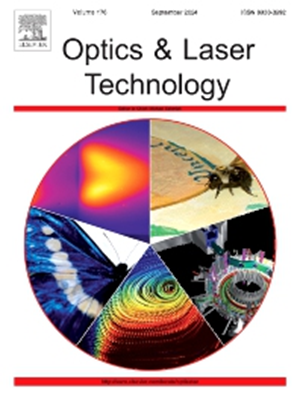Laser shock peening without coating for WAAM printed aluminum alloys: Impacts on porosity, microstructure, and surface quality
IF 4.6
2区 物理与天体物理
Q1 OPTICS
引用次数: 0
Abstract
Wire Arc Additive Manufacturing (WAAM) using aluminum alloys supports high deposition rates and the production of geometrically complex components, making it viable for aerospace components and rapid prototyping. Though, WAAM tends to introduce tensile residual stresses, porosity, and poor surface integrity, which compromise mechanical performance. In this study, laser shock peening without coating (LSPwC) was used as a post-processing method to overcome these drawbacks. LSPwC generated beneficial compressive residual stresses (>90 MPa to 1 mm), improved the microstructure, and decreased porosity by more than 50 % along with visible alterations in pore shape. Although surface roughness was enhanced by the lack of a protective layer during peening, surface hardness was found to improve. These findings prove the prospect of combining LSPwC with WAAM towards more efficient and durable production of high-performance aluminum parts.
无涂层WAAM印刷铝合金的激光冲击强化:对孔隙率、微观结构和表面质量的影响
使用铝合金的电弧增材制造(WAAM)支持高沉积速率和几何复杂部件的生产,使其适用于航空航天部件和快速原型制作。然而,WAAM往往会引入拉伸残余应力、孔隙率和较差的表面完整性,从而影响机械性能。在本研究中,采用无涂层激光冲击强化(LSPwC)作为后处理方法来克服这些缺点。LSPwC产生了有益的残余压应力(>;90 MPa至1 mm),改善了微观结构,孔隙率降低了50%以上,孔隙形状也发生了明显的变化。虽然在喷丸过程中由于缺乏保护层而提高了表面粗糙度,但发现表面硬度有所提高。这些发现证明了LSPwC与WAAM相结合的前景,可以更高效、更耐用地生产高性能铝部件。
本文章由计算机程序翻译,如有差异,请以英文原文为准。
求助全文
约1分钟内获得全文
求助全文
来源期刊
CiteScore
8.50
自引率
10.00%
发文量
1060
审稿时长
3.4 months
期刊介绍:
Optics & Laser Technology aims to provide a vehicle for the publication of a broad range of high quality research and review papers in those fields of scientific and engineering research appertaining to the development and application of the technology of optics and lasers. Papers describing original work in these areas are submitted to rigorous refereeing prior to acceptance for publication.
The scope of Optics & Laser Technology encompasses, but is not restricted to, the following areas:
•development in all types of lasers
•developments in optoelectronic devices and photonics
•developments in new photonics and optical concepts
•developments in conventional optics, optical instruments and components
•techniques of optical metrology, including interferometry and optical fibre sensors
•LIDAR and other non-contact optical measurement techniques, including optical methods in heat and fluid flow
•applications of lasers to materials processing, optical NDT display (including holography) and optical communication
•research and development in the field of laser safety including studies of hazards resulting from the applications of lasers (laser safety, hazards of laser fume)
•developments in optical computing and optical information processing
•developments in new optical materials
•developments in new optical characterization methods and techniques
•developments in quantum optics
•developments in light assisted micro and nanofabrication methods and techniques
•developments in nanophotonics and biophotonics
•developments in imaging processing and systems

 求助内容:
求助内容: 应助结果提醒方式:
应助结果提醒方式:


